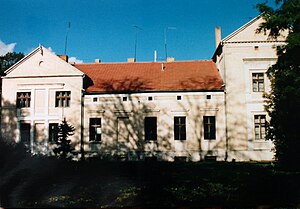Tupadły (Kcynia)
| Tupadły | ||
|---|---|---|

|
|
|
| Basic data | ||
| State : | Poland | |
| Voivodeship : | Kuyavian Pomeranian | |
| Powiat : | Nakło nad Notecią | |
| Gmina : | Kcynia | |
| Geographic location : | 53 ° 0 ′ N , 17 ° 30 ′ E | |
| Residents : | 328 (March 31, 2011) | |
| Telephone code : | (+48) 52 | |
| License plate : | CNA | |
| Economy and Transport | ||
| Street : | Ext. 241 Wągrowiec - Nakło nad Notecią | |
| Next international airport : | Ignacy Jan Paderewski Airport Bydgoszcz | |
Tupadły (German Gut Tupadly ) is a village within the powiat Nakielski of the Polish Kuyavian-Pomeranian Voivodeship . The village is as a Schulzenamt ( sołectwo ) district of the rural community Kcynia (Exin).
Geographical location
Tupadły is located about 500 meters west of the voivodship road 241 ( Droga wojewódzka nr 241 ) from Wągrowiec to Nakło nad Notecią and about 2 kilometers northeast of Kcynia.
history
The place name is probably derived from the Polish verb tupać , which means something like 'stomp' or 'trample' and is associated with the cultivation or processing of flax . Tupadły was mentioned as a settlement of the Pałuków family as early as 1394, until it came into the possession of a Thupadli Vogt in 1396 . The place was owned by the Thupadli or Tupadli family until the end of the 15th century. In 1480 there is a Michael Drogosch as the owner of Tupadły, at that time also listed as Tupadla . From 1521 to 1539 the place, which changed its name more frequently in the 16th century - sometimes it appears as Thupadla (1577) or Tupadli (1580) - was called a city. The property was divided between members of one and various Polish noble families, including the Siernicki, Lankowski, Obodowski and Latalski. Ownership often changed through marriage, possibly also through leasing of the land. It is also possible that the village was expanded during this time. The more important part of the village was called Great Tupadł . In the following century the estate came into the hands of Grocholski, Baranowski and Piekarski. Tupadły was originally a farm or a subsidiary of the Dembogora estate ( Dębogóra ). The heirs of the owners of Dębogóra were also the owners of Tupadły in the 18th century. In 1741, the Manteuffel-Kiełpiński family acquired the property together with Dębogóra and Dębogóra Mill ( Dębogórski Młyn ).
The first partition of Poland brought the place to Prussia in 1772 . Victor Manteuffel-Kiełpiński from Dębogóra was the last Polish owner of the village. On June 9, 1785, his heirs sold part of the property to Pastor Paul Piekarski. Three years later, on August 24, 1787, the entire property was finally sold to Michael Hieronimus Baranowski. From 1807 to 1815 the village belonged to the Duchy of Warsaw , when it consisted of 7 fireplaces. In 1830 a certain Rosalie Michalski Tupadły acquired, which had belonged again to Prussia in the Schubin district since 1815 . At that time the Tupadly estate comprised around 570 hectares. By marrying the estate agent Georg Busse, the German family Busse now came into possession of the village and estate. In 1918 the owners belonged to the German minority in Poland. Until 1939 the place was part of the Polish national territory. At the time of the German occupation, the place was renamed Walburg in 1939 and became part of the Altburgund district .
The Busse family managed the estate until 1945. In addition to growing grain, cattle breeding, pig fattening and sheep were part of the estate management. In addition, the estate also included 200 hectares of forest. In the middle of the 19th century the estate was known for breeding the Black and White East Frisians . Later this one belonged to the best dairy herd in Poland (Tupadlyer young bulls) and received several awards. In 1939 the estate comprised 417 hectares of usable agricultural area. The Busse family rebuilt the existing manor house and expanded the farm buildings from the second half of the 19th century. The manor complex consisted of three parts: the stately park, the main house with farm buildings and a residential area for the workers. In 1945 the German population fled from the Soviet Army . This caught up with the trek on January 24, 1945 and shot some of the fugitives, including the manor owner Georg Busse.
The village is now in the powiat Nakielski in the Kuyavian-Pomeranian Voivodeship and was categorized as formerly German property. After the war it passed to the Polish state. From this the local Chamber of Agriculture developed. In 1993 the property was acquired by the Agricultural Property Agency from the Ministry of Finance. A substantial part of the former property has been leased as a farm complex since 1995.
Personalities
- Georg Busse (1871–1945), member of the Posenen and Prussian state parliaments, senator in the Polish parliament
literature
- Anna Koebernick : Goods and manor houses in the Schubin district . Celle, 1978.
- Sławomir Łaniecki: Nadnoteckie pałace, dwory, folwarki, krajny i paluk . Nakło nad Notecią, 2010.
Web links
Footnotes
- ^ CIS 2011: Ludność w miejscowościach statystycznych według ekonomicznych grup wieku (Polish), March 31, 2011, accessed on July 4, 2017
- ↑ Friedrich Justin Bertuch: General geographical ephemeris. Volume 29, 1809, p. 319 .
- ^ Official Journal of the Royal Prussian Government in Bromberg. Government Official Gazette, 1831, p. 1078 .
- ↑ Beata Dorota Lake Mountain : The German minority press in Poland 1918-1939 and its Polish and Jewish image. 2010, p. 318 .

